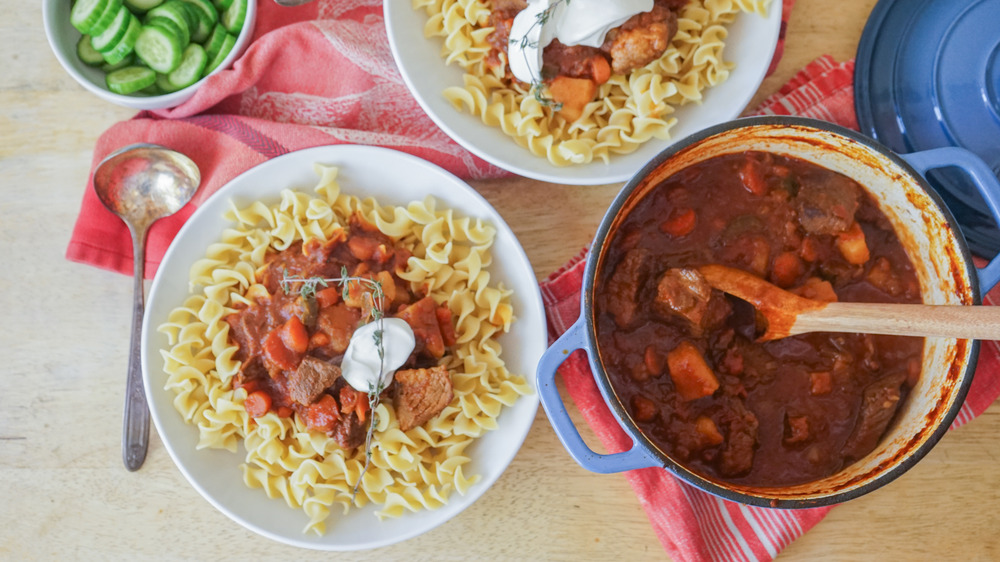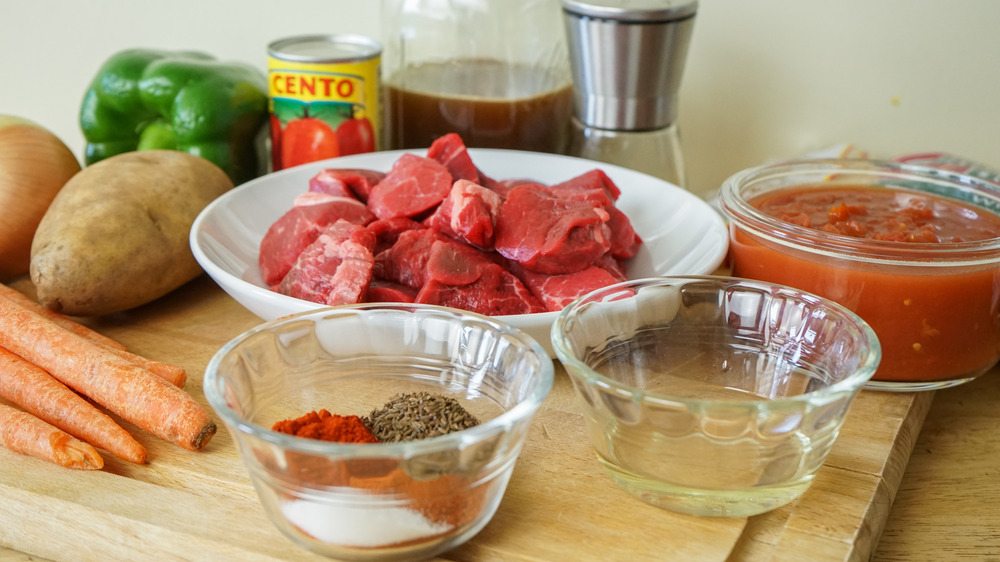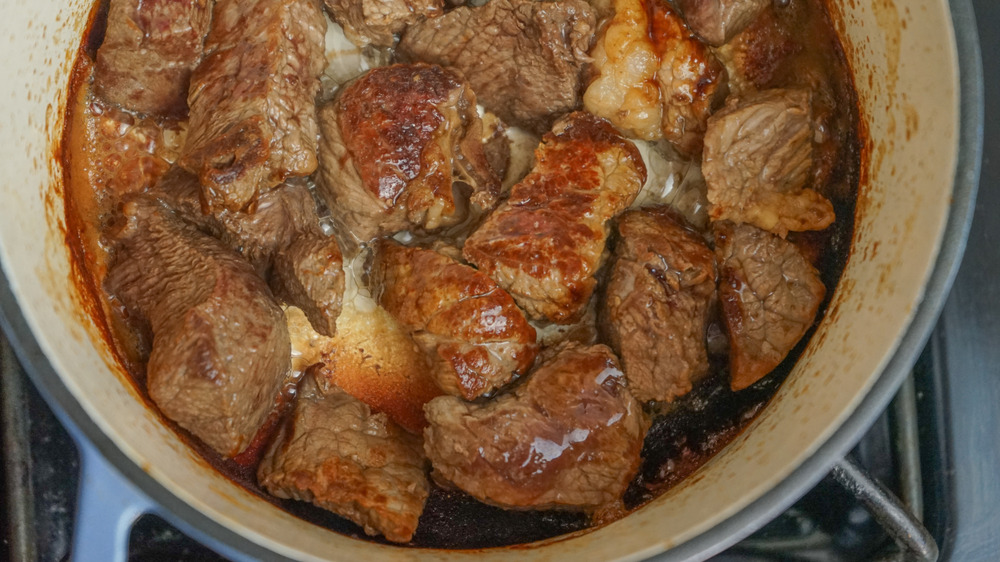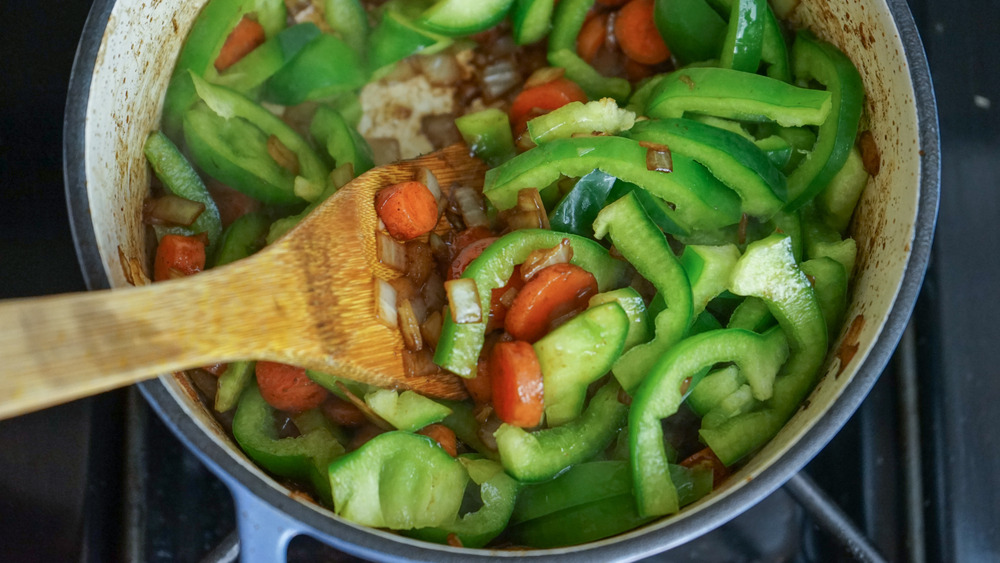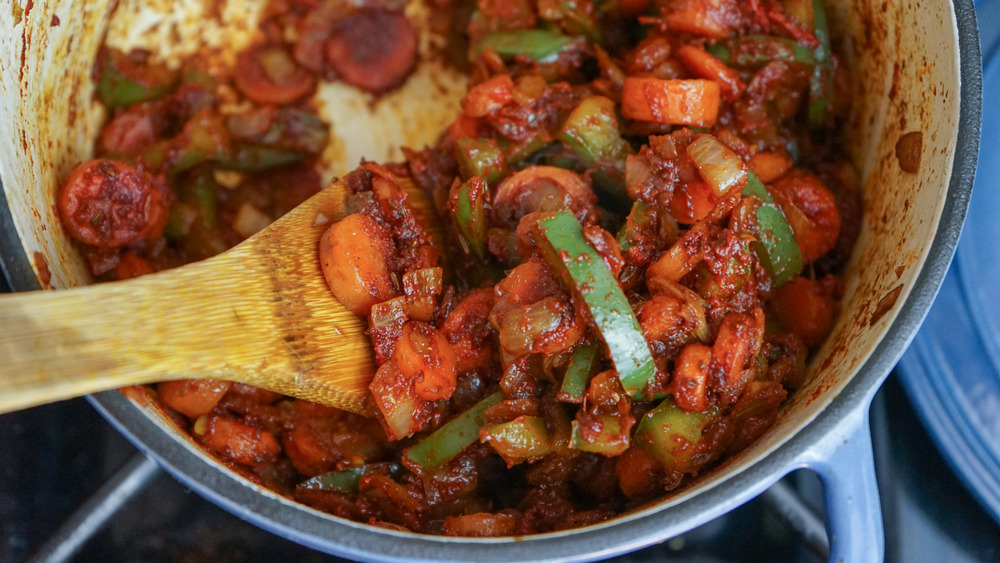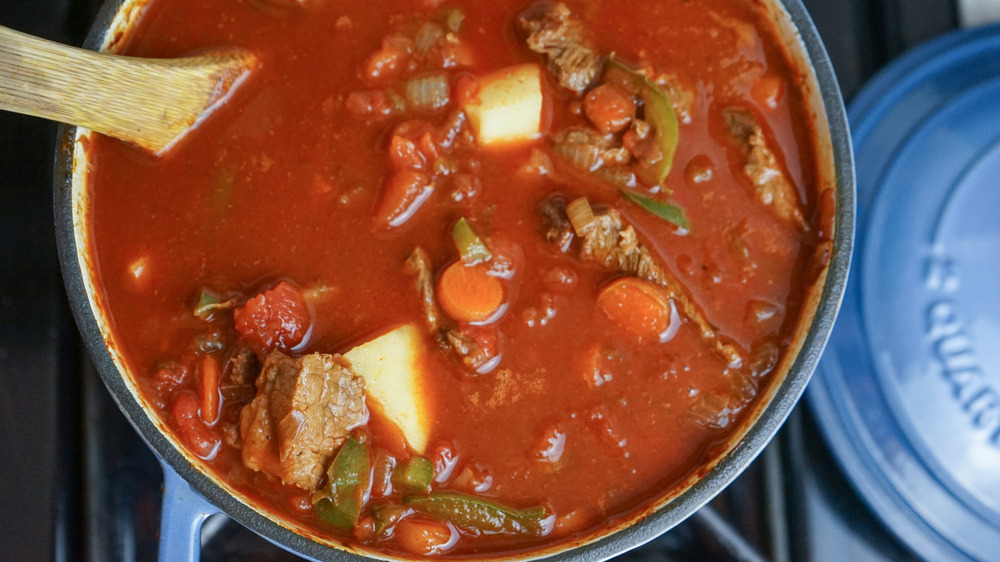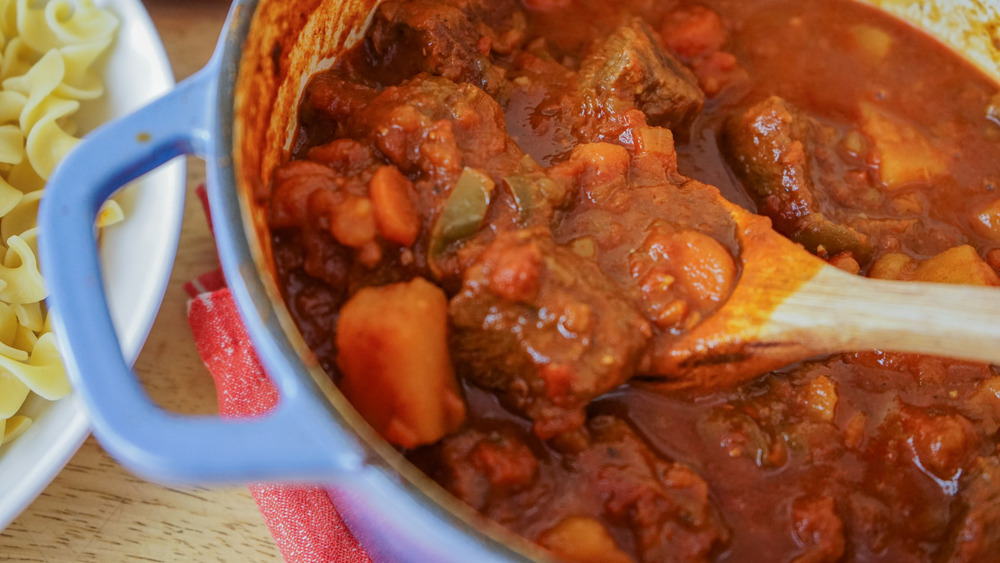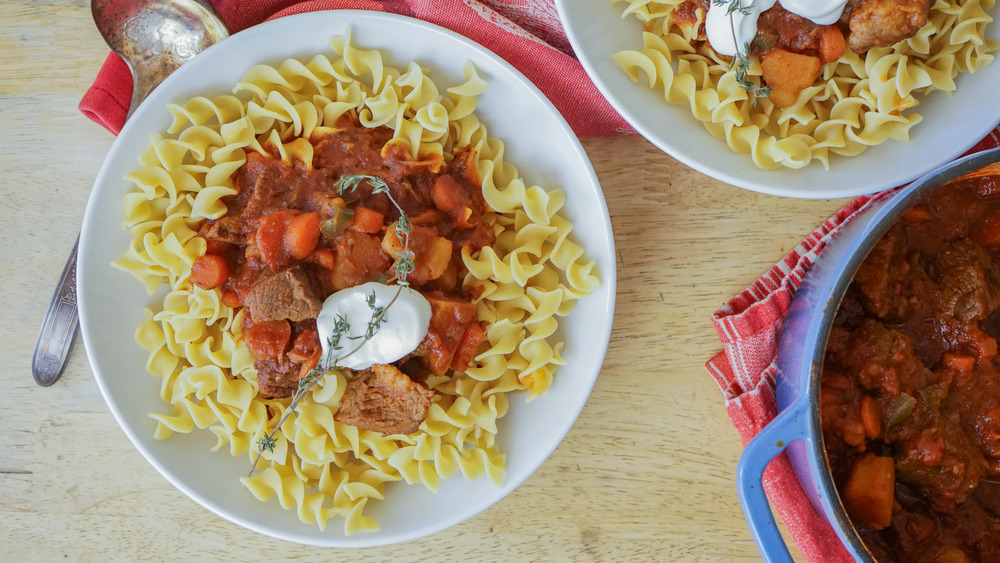Hungarian Goulash Recipe
Sometimes you just want something hearty that's going to stick to your ribs. Goulash is the perfect dish for such a meal. The Eastern European classic is made with beef, paprika, and various spices and vegetables. It's essentially just a beef stew. But this humble mixture can trace its history back to sheepherders called Magyars in what is now Hungary. The shepherds actually used dried meat and other flavorings, which they reconstituted with water heated in cauldrons (yes cauldrons) for a portable dinner.
Paprika and tomato are likely more recent additions to what the shepherds had boiling away on the fire — but anyone who's tried this dark red-brown all-in-one meal could attest that they were a good idea. And though goulash recipes, like any popular food, come in infinite variations, caraway seeds are included in this one, and are in many others. It's a matter of preference, but caraway adds a hint of sharpness that goes well with the richness of beef, onion, and sauteed veggies. And for this recipe ... no cauldron needed!
Smoked and regular paprika add complexity to the goulash
Any Hungarian worth their salt (or paprika) will tell you that this spice is the key to the distinctive, deeply warming flavor of goulash. A combination of regular paprika and smoked paprika lends this recipe a smoky edge that harkens back to the old days when this stew was cooked over an open flame. Hungarian paprika is best, and it usually comes in a tin box or even a tube of paste at a specialty store. But if you can't find it then opt for the freshest paprika you can find, and pay attention to those expiration dates on the bottle. This stew demands fresh, full flavor!
Brown the Hungarian goulash's beef for maximum flavor
Another key to achieving depth of flavor is browning or searing the beef on high heat before doing anything else. Many stews and meat dishes that incorporate liquid call for this. Not only does browning lend a pleasant golden brown appearance (and we do eat with our eyes), but it adds the unique hit of flavor and crispy crust that can only be achieved with the Maillard reaction. This chemical reaction from browning foods gives everything from fried dumplings to seared tuna an explosion of new flavors that simply cooking beef through or (the horror!) boiling it can never accomplish. Beef is just better browned.
Sautee the veggies in order of cook time
There are a number of considerations that go into sauteing vegetables, but making sure they cook through to a relatively uniform texture is a big one. One way to ensure this is by starting with veggies that take longer to cook.
Just as you would sautee onions before adding mushrooms, giving carrots a head start, and ending with peppers, ensures that the stubborn carrots don't end up harder than everything else and that the softer, more water-laden peppers don't turn to mush while the carrots soften up. Granted, everything in a stew gets cooked through enough for this not to be a top concern, but starting with a uniformly cooked base of veggies never hurts anyone.
Bloom those Hungarian goulash spices
Before adding liquid to the fatty base of your veggies, the paprika and caraway seeds get an abbreviated "blooming" treatment. This technique, which is commonly used in South Asian cooking, draws out maximum flavor from spices before the liquids come pouring in to dilute everything. According to Bon Appetit, the flavor compounds in our recipe's spices are "fat-soluble," and giving them a light toast in oil brings out the spices' unique aromas and flavors.
Simmer, don't boil for tender beef
As Andrew Zimmern recently reminded us, a boiled piece of meat is a tough piece of meat. Simmering, on the other hand, renders the fat in the connective tissue of the beef just enough to tenderize it, and skipping this step is a common beef stew mistake. Shoot for a simmer temperature of 180. Any higher and the proteins will tighten up and seize, yielding an unpleasantly chewy texture that will have you breaking out a knife and fork to eat stew. And no one wants that. So make sure to watch for small bubbles when you bring the heat up on your stew and bring the heat down to low before large bubbles form.
Starches in the potatoes will thicken the Hungarian goulash
This is a true exemplar of the meat-and-potatoes meal. Though this stew isn't as thick as, say, a three-bean chili, it gets a little bit of heft from potatoes that can stand up to the heat and give off some starch. Adding cubed potatoes bulks up the rich stew while ensuring that it doesn't get too runny. Starch from the potatoes is released while they cook, acting like corn starch or flour might in other dishes. If you like your stew even thicker, add more potatoes or even one of the above thickening agents while sauteing the veggies.
Hungarian goulash is even better the next day
Perhaps you've heard that soups and stews are better a day after cooking. There's just something about letting a dish sit overnight that seems to lend it a more rounded out, mellow flavor than the first night. And while Serious Eats did some kitchen testing and didn't notice huge differences in taste, there may be more to this age-old promise than just the power of expectation. The Serious Eats cook did note that foods do change as they "age": molecules break down and proteins change form. So, rest assured that if your goulash isn't gobbled up the night you make it, it could taste even more delicious (or at the very least, just as good) on round two.
Hungarian Goulash
Nothing hits the spot on a cold day quite like beef stew. Hungarian goulash is a savory beef stew full of smoky flavor thanks to a robust blend of spices.
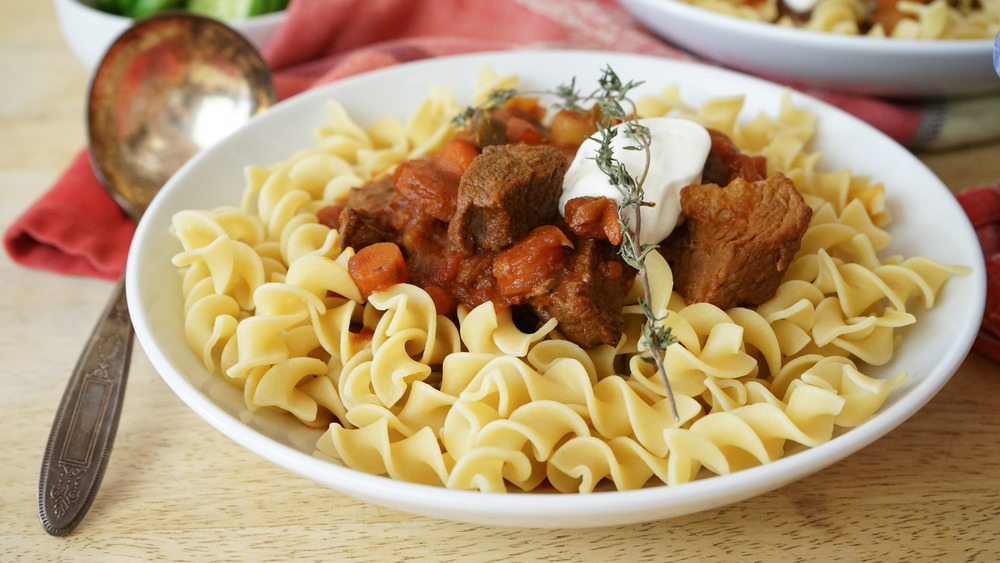
Ingredients
- 1.5 pounds stew beef, cubed
- 1 teaspoon kosher salt + to taste
- 1 teaspoon freshly ground black pepper + to taste
- 3 tablespoons vegetable oil
- 1 medium onion, small dice
- 1 medium Idaho potato, large dice (about 1 inch)
- 5 small carrots or 2 large carrots, small rounds (about ⅓ inch)
- 1 green pepper, medium slices
- 1 tablespoon tomato paste
- 1 1/2 cups crushed tomatoes
- 2 tablespoons paprika
- 1 tablespoon smoked paprika
- 1 1/2 teaspoons caraway seeds, crushed with mortar and pestle
- 1 1/2 cups beef broth
Optional Ingredients
- egg noodles
- sour cream
Directions
- Cut beef down to uniform 1.5 inch cubes if needed and season with a generous sprinkle of salt and pepper.
- Heat Dutch oven or other heavy pot, without oil, until very hot.
- Place beef cubes in a single layer in the pot on high heat and sear until browned, about 5 minutes on one side and 3 minutes on another, working in batches if needed, then set beef aside.
- Put oil in the pot and lower heat to medium. Add carrots to oil and sautee until slightly softened, about 5 minutes. Add onions and saute for 5 more minutes, then green peppers and sautee all until softened and lightly browned, about 5 more minutes.
- Add in paprikas, caraway seeds, and remaining salt and pepper and mix to combine.
- Mix in beef cubes, then potatoes, tomato paste, crushed tomatoes, mixing to incorporate after each addition.
- Add beef stock and stir all ingredients until completely combined.
- Raise heat to high and bring the stew to a light simmer. Lower heat to low and cover the dutch oven with the lid slightly off to let some liquid evaporate.
- Cook stew for one hour, mixing once or twice to keep ingredients from sticking.
- Remove stew from heat, and let sit about 15 minutes until slightly thickened and serving temperature. Serve with optional egg noodles and dollops of sour cream.
Nutrition
| Calories per Serving | 467 |
| Total Fat | 20.1 g |
| Saturated Fat | 4.3 g |
| Trans Fat | 0.5 g |
| Cholesterol | 107.2 mg |
| Total Carbohydrates | 33.1 g |
| Dietary Fiber | 8.2 g |
| Total Sugars | 10.6 g |
| Sodium | 1,035.9 mg |
| Protein | 43.6 g |
